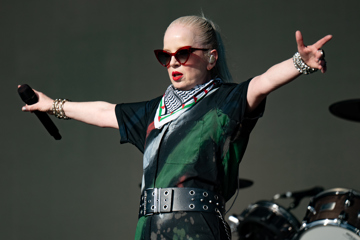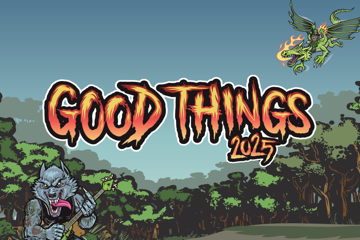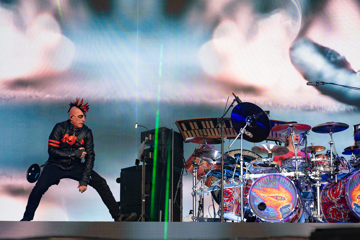Fans Want To See More Aussie Acts But They Don’t, So How Will The Biz Deal With It?
“There is a disconnect between Australians’ strong support for Australian artists and actual attendance at Australian acts,” related Creative Australia’s Belinda Balhatchet.

The Living End @ Corner Hotel, Melbourne (Credit: Save Our Scene/Supplied)
A high percentage (62 per cent) of Australians consider music to be really important to them, and 66 per cent want to listen to more Australian music.
Attending live music events is exhilarating for them. 92 per cent reckon attending these has a “big” or “very big” impact on their sense of wellbeing and happiness.
The 18-24 demo is the most likely age group to present itself. The more music-engaged attend three to five events a year, and 48 per cent would like to attend more events featuring Australian artists.
But the problem is, they don’t.
“There is a disconnect between Australians’ strong support for Australian artists and actual attendance at Australian acts,” related Belinda Balhatchet, Research Program Manager (Partnerships) of the federal government’s Creative Australia.
Fans are prioritising international acts for Fear of Missing Out, as they are less likely to play here. Meanwhile, attendance at smaller venues, where most new music is discovered, is down.
Don't miss a beat with our FREE daily newsletter
Balhatchet was speaking yesterday (April 29) at the launch of Listening In: Insights On Live Music Attendance as part of the Victorian Music Development Office (VMDO)’s two-day Music Data and Insights Summit in Melbourne.
The study was delivered by the Creative Australia research team for Music Australia, in partnership with promoter Untitled Group and social-first news service The Daily Aus, and in collaboration with Victorian youth music organisation The Push.
Cost of Living
The thrust of the report is that the cost of living does impact spending habits, and the growing costs of tickets, travel, food, and drinks top the list of reasons why a fan might have second thoughts about attending.
Artists and the style of music remain the greatest drawcard. But there is a greater comparison in ticket prices for similar-level events. Other reasons for bypassing a gig are not having someone to go with or not having the time.
While other investigations suggested safety as a major consideration, it was only a barrier for 2 per cent of Listening In’s respondents.
A problem with analysing support for live music, noted Balhatchet, is the wider social change. “These days, young Australians are more likely not to go out, compared to 2019.”
But the results of the research indicate a problem for smaller venues, especially those that depend on bar takings to try and break even.
There is a change in drinking behaviour among Gen Zers. 97 per cent of music-engaged respondents drink alcohol at live music events.
Because they see alcohol as expensive, many go for a cheaper option. Half (54 per cent) drink before arriving at the venue to get in the mood to socialise, and 19 per cent don’t drink afterwards.
Of concern is that cash-strapped venues don’t market themselves enough or miss the target.
51 per cent of respondents reveal they’d like to attend more local gigs, but don’t know where to find out about them.
Or they find out about them after the show. Many express the opinion that music offered by some venues simply doesn’t appeal to them.
Data
The Australian live sector has long suffered from a lack of detailed data on how to move forward as the landscape changes and the best business model to adopt.
The new Listening In is the first of a three-part look at changes in the live music sector. Creative Australia and Music Australia’s deep dive into how Australians discover and consume music, along with audiences’ wider attitudes, behaviours and preferences, is timely.
Solutions are needed as to why audiences continue to buy tickets later, the risks and challenges, like promoters unable to get cancellation insurance, and the continued lack of skills in the workforce, like lighting designers.
It also seeks to better understand how Australian music fits within the overall music consumption habits, as well as how people feel about local music, and their current access to it.
Director of Music Australia, Millie Millgate, commented: “We know Australians value live music, and they continue to seek out the chance to experience it, even when times are tough.
“People still save for gigs that matter to them, showing there’s still a strong appetite for live music – especially experiences that feel rare and bring people together.
“This report builds on the insights of our Soundcheck reports (which focused on music festivals) and helps to provide a clearer picture of how Australians discover and engage with Australian music.
“This research provides valuable insights into how Australians are responding to the multiple changes impacting the sector. It will help guide our work and give the industry insights to better connect with audiences.”
Power
Untitled Group co-founder and Managing Partner, Michael Christidis, added: “At Untitled Group, we see firsthand the power of live music to create unforgettable moments and connection — especially among young Australians.
“This research confirms what we experience on the ground: even in tough economic times, people prioritise live music for its emotional and social value.
“We’re proud to have partnered with Music Australia and The Daily Aus, in collaboration with The Push, to help bring these insights to light. It’s a call to action for the industry to ensure that live music remains a shared, accessible cultural experience.”
Over the next 12 months, there’ll be more studies from Creative Australia and Music Australia.
The next, in June, investigates the economic set-up of the local music industry.
Also bridging the big gap in First Nations music this year is a dedicated policy looking at its strengths and challenges, how it is shaped by its creatives, and how it is recognised by the wider music community.
Other inquiries are also being conducted – with the help of academics, government departments, music industry associations, and executives – on children’s music, community radio, tax initiatives, export markets, and commercial rates for jazz, classical, and sound art.
Australia-wide reform needs to include a ban on dynamic pricing, resale of tickets at higher prices, protecting the live music ecosystem, and more aid for artists to be discovered through their own socials and websites.







